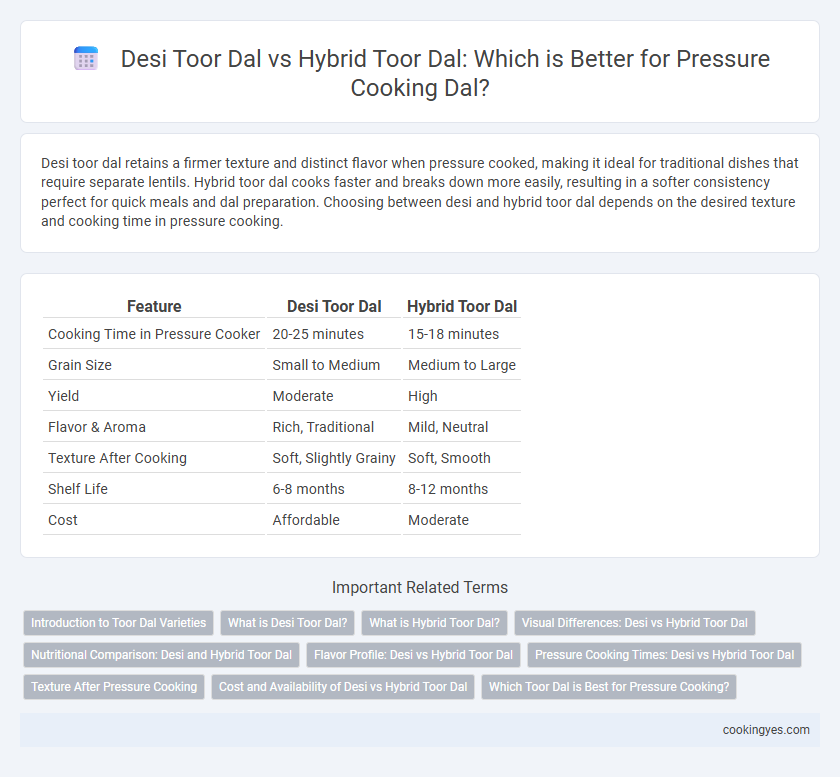Desi toor dal retains a firmer texture and distinct flavor when pressure cooked, making it ideal for traditional dishes that require separate lentils. Hybrid toor dal cooks faster and breaks down more easily, resulting in a softer consistency perfect for quick meals and dal preparation. Choosing between desi and hybrid toor dal depends on the desired texture and cooking time in pressure cooking.
Table of Comparison
| Feature | Desi Toor Dal | Hybrid Toor Dal |
|---|---|---|
| Cooking Time in Pressure Cooker | 20-25 minutes | 15-18 minutes |
| Grain Size | Small to Medium | Medium to Large |
| Yield | Moderate | High |
| Flavor & Aroma | Rich, Traditional | Mild, Neutral |
| Texture After Cooking | Soft, Slightly Grainy | Soft, Smooth |
| Shelf Life | 6-8 months | 8-12 months |
| Cost | Affordable | Moderate |
Introduction to Toor Dal Varieties
Desi Toor Dal and Hybrid Toor Dal differ primarily in their seed varieties, with Desi Toor Dal being traditional, larger-grained, and often preferred for its authentic flavor profiles in pressure cooking. Hybrid Toor Dal, developed through agricultural advancements, offers higher yields and faster cooking times while maintaining nutritional content. Pressure cooking toor dal benefits from selecting the hybrid variety due to its reduced cooking duration and consistent texture without compromising the classic taste.
What is Desi Toor Dal?
Desi Toor Dal, also known as traditional or local toor dal, is a lentil variety with a robust, earthy flavor and coarser texture compared to Hybrid Toor Dal, making it ideal for authentic Indian pressure-cooked dishes. The denser grains of Desi Toor Dal require slightly longer cooking times in a pressure cooker but yield a rich, nutritious dal rich in protein and fiber. Unlike Hybrid Toor Dal, which is bred for faster cooking and higher yields, Desi Toor Dal retains its natural taste and nutritional profile, preferred by connoisseurs of traditional Indian cuisine.
What is Hybrid Toor Dal?
Hybrid Toor Dal is a genetically improved variety of pigeon peas developed for higher yield and disease resistance compared to traditional Desi Toor Dal. It cooks faster under pressure due to its optimized seed structure and lower fiber content, making it ideal for quick meal preparation. Farmers and consumers prefer Hybrid Toor Dal for its enhanced nutritional profile and consistent cooking quality.
Visual Differences: Desi vs Hybrid Toor Dal
Desi Toor Dal typically has smaller, rounder grains with a rougher texture compared to the larger, smoother, and more uniform grains of Hybrid Toor Dal. The color of Desi Toor Dal ranges from dull yellow to light brown, whereas Hybrid Toor Dal usually exhibits a brighter, golden yellow hue, making it visually distinct. These differences affect not only appearance but also cooking time in pressure cooking, with Hybrid Toor Dal generally cooking faster due to its larger size and softer texture.
Nutritional Comparison: Desi and Hybrid Toor Dal
Desi Toor Dal contains higher fiber content and essential minerals such as iron and calcium compared to Hybrid Toor Dal, which offers increased protein levels and faster cooking times suitable for pressure cooking. Nutritionally, Desi Toor Dal is rich in antioxidants and traditional phytochemicals, supporting digestive health, while Hybrid Toor Dal provides enhanced yield and consistency with moderate nutrient retention. For pressure cooking, Hybrid Toor Dal softens quicker due to its breeding for uniformity, whereas Desi Toor Dal requires longer cooking but delivers a more robust nutritional profile.
Flavor Profile: Desi vs Hybrid Toor Dal
Desi Toor Dal offers a robust, earthy flavor with a slightly nutty aroma that intensifies when slow-cooked, making it ideal for authentic Indian dishes. Hybrid Toor Dal, bred for higher yields, has a milder taste and softer texture, which shortens pressure cooking time but results in a subtler flavor profile. Choosing between Desi and Hybrid Toor Dal depends on the desired balance between traditional taste and cooking efficiency.
Pressure Cooking Times: Desi vs Hybrid Toor Dal
Desi toor dal typically requires longer pressure cooking times, around 15-20 minutes, due to its denser texture and traditional seed hardness. Hybrid toor dal cooks faster, generally taking 10-12 minutes, attributed to selective breeding for softer seeds and improved water absorption. Adjusting pressure cooking times based on dal type ensures optimal texture and nutrient retention in the final dish.
Texture After Pressure Cooking
Desi toor dal typically yields a softer, creamier texture after pressure cooking due to its traditional grain structure and higher starch content. Hybrid toor dal, while faster cooking, often retains a firmer texture with slightly less mashability, making it ideal for dishes requiring distinct dal grains. Choosing between Desi and Hybrid toor dal depends on desired texture, with Desi preferred for smooth consistency and Hybrid favored for a more textured outcome.
Cost and Availability of Desi vs Hybrid Toor Dal
Desi toor dal is generally more affordable and widely available in local markets compared to hybrid toor dal, which tends to have a higher price due to improved yield and resistance traits. Hybrid toor dal often requires specific sourcing from agricultural suppliers or premium grocery stores, limiting its accessibility for everyday consumers. Pressure cooking with desi toor dal remains cost-effective for households aiming for budget-friendly, traditional meals without compromising on flavor.
Which Toor Dal is Best for Pressure Cooking?
Desi Toor Dal, known for its traditional taste and firm texture, retains its shape well during pressure cooking, making it ideal for dishes requiring distinct lentil grains. Hybrid Toor Dal, bred for faster cooking and higher yield, tends to soften more quickly and break down, suitable for soups and purees. Choosing the best Toor Dal depends on the desired consistency: Desi Toor Dal offers a robust texture, while Hybrid Toor Dal ensures quicker cooking and creamier results.
Desi toor dal vs Hybrid toor dal for pressure cooking Infographic

 cookingyes.com
cookingyes.com